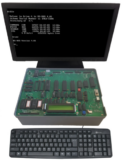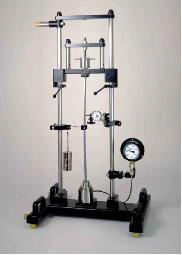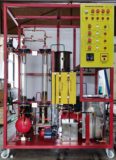Buckling Behavior of Bars Model MT 023
Home » Products » Buckling Behavior of Bars Model MT 023
Buckling Behavior of Bars Model MT 023
Sci-tech Buckling Behavior of Bars Model MT 023 investigates the buckling behavior of bars under various influences. All relevant buckling problems are demonstrated by way of experimentation. For the purpose, one end of a bar is fixed or pinned, depending on the buckling case. A height-adjustable load-carrying cross-arm and a hand-operated spindle are used to apply compressive force to the bar. An axial bearing between the spindle and the bar support prevents torsional loading of the test bar. A hydraulic load cell measures the applied force and indicates it on a pressure gauge. The lateral deflection of the bar is indicated on a dial gauge. Experiments demonstrate various influences, such as bar lengths, materials and methods of support. A transverse load application device can be used to generate additional shear forces on the test bar.
| Size: | 55cm x 40cm x 95cm (LxWxH) |
| Weight: | 35 kg |
Item Description
Features
* Investigation of all relevant buckling problems1
* Verification of the Euler Theory of buckling1
* Methods of force and deflection measurement1
* Supplementary set for experiments with eccentric
application of force and transverse loading 1
* Comprehensive instructional material
In technical mechanics, loss of stability is known as buckling. Under the effects of compressive forces, and under increasing load, the axis of the bar deflects laterally until it suddenly and violently fails (collapses), even before the fracture point is reached. The stresses in the bar often remain within the elastic range during this process.
Sci-tech Buckling Behavior of Bars Model MT 023 investigates the buckling behavior of bars under various influences. All relevant buckling problems are demonstrated by way of experimentation.
For the purpose, one end of a bar is fixed or pinned, depending on the buckling case. A height-adjustable load-carrying cross-arm and a hand-operated spindle are used to apply compressive force to the bar. An axial bearing between the spindle and the bar support prevents torsional loading of the test bar. A hydraulic load cell measures the applied force and indicates it on a pressure gauge. The lateral deflection of the bar is indicated on a dial gauge.
Experiments demonstrate various influences, such as bar lengths, materials and methods of support. A transverse load application device can be used to generate additional shear forces on the test bar.
The experimental unit can be operated vertically or horizontally. The load gauge can be rotated 90° to adjust to the chosen option. A supplementary set extends the scope of experimentation offered by Sci-tech Buckling Behavior of Bars Model MT 023
The various elements of the experiment are clearly laid-out and housed securely in a storage system.
See also different:

The trainer consists of combination of microprocessor, RAM, ROM etc. Microprocessor of 32/64 bit Core i3 Microprocessor Complied with 32 / 64 bit Trainer is provided with keyboard having hexadecimal and function keys 15” LCD TFT Display Facili [...]



